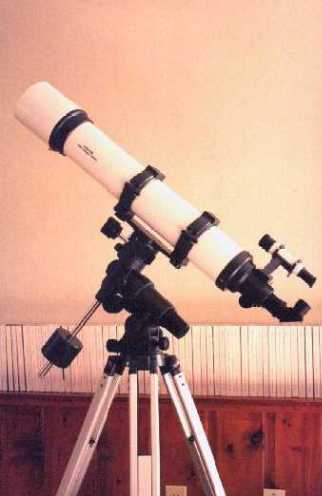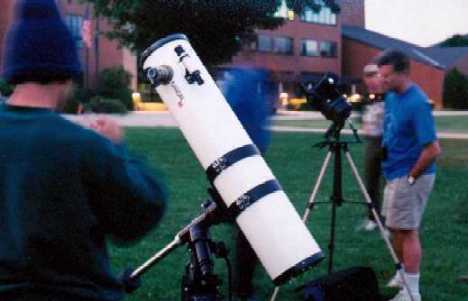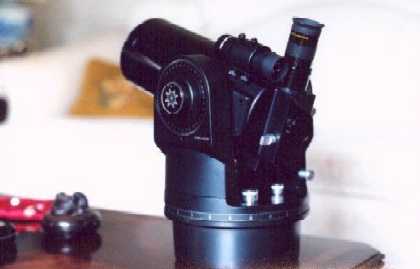
| Your First Telescope | |
| Articles | AstroGuide | Calendar | Classifieds | Constellations | Forums Meteors | Moon | News | Photography | Planets | Shop | Other Sites |
|

 |
|
 |
|||
|
|
|||||
by
Ed Ting
Telescopes!
Ask a roomful of people what the purpose of a telescope is, and chances are they will say something like, "to make distant objects look bigger." I'm a frequent guest speaker at local schools, and I always get that answer (or something close to it) when I ask that question.
Is the primary function of a telescope really to make things look bigger? Take this test. Step outside on a clear night from a brightly lit room. See anything? Probably not. But it gets better after a few minutes, doesn't it? In fact, after a while, you'll wonder why you didn't see all those stars before. What made it better? Did you change the magnification, or make the apparent size of anything change? Of course not. What you DID change, was the amount of light your eye gathered, when your pupils opened to compensate for the darkness.
So, the primary function of a telescope is to gather light.
The more light a scope gathers, the more powerful it is. And remember, telescope apertures are circles, and the areas of circles increase with the square of the radius, so moving up in aperture, even modestly, can yield big results. Our hypothetical 7X50 binoculars (above) gather over twice the light of the 7X35's, even though they look about the same size. Put another way, the owner of an 10" Schmidt-Cassegrain who decides to upgrade to a 12" will see a 44% increase in light-gathering ability. Not bad for a 2" increase, eh?
So, you should buy the biggest telescope you can afford, right?
The answer, is an unqualified MAYBE, and for some people, the answer will be NO. But we're getting ahead of ourselves.
Types of Telescopes
Modern amateur telescopes can be divided into three classes:
1) The refractor is what most people think of when they hear the word "telescope". Refractors gather light with an objective lens at one end and focus the light at the eyepiece at the other end. Refractors were almost extinct at one point, but modern glass elements (including an exciting new artificially grown crystal known as fluorite) have brought the refractor back to prominence.
Refractor advantages: Potential for the best images, no obstruction in light path.
Refractor disadvantages: Some secondary color ("chromatic aberration") still visible in all but the best units, large aperture instruments can be massive, most expensive of the three designs (often by a large margin), "Guilt By Association" with horrible department store refractors.

A typical 4" refractor
2) The Newtonian Reflector, invented by Sir Issac Newton, uses a parabolic mirror at the end of a tube and focuses the light back at the front of the tube, where the eyepiece sits, after being deflected by a smaller secondary mirror in the light path.
Reflector advantages: Cheapest of the three designs (especially those on Dobsonian mounts), more portable than refractors of similar aperture, inherently color free (no chromatic aberration).
Reflector disadvantages: Secondary obstruction results in some loss of contrast, still quite large compared with Schmidt-Cassegrains, can require frequent collimation (alignment) of optics.

An 8" Newtonian Reflector
3) The Schmidt-Cassegrain and its derivatives (Maksutov-Cassegrain, Classical Cassegrain, etc.) use BOTH mirrors and lenses to fold the optical path back onto itself, resulting in a compact tube. The technical term for these scopes is catadioptrics, but since nobody seems to use this term, I won't.
S-C Advantages: Most compact of the three designs, less expensive than refractors, huge assortment of after-market accessories, can be totally computer driven, very popular.
S-C disadvantages: More expensive than reflectors, images are potentially the worst of the three designs (notice I said "potentially!"), most subject to dew of the three designs.

[Beginning] - [Next Page - Which one should I choose?]
| Additional Information |
|---|
| About Astronomy Net | Advertise on Astronomy Net | Contact & Comments | Privacy Policy |
|
Unless otherwise specified, web site content Copyright 1994-2025 John Huggins All Rights Reserved "dbHTML," "AstroGuide," "ASTRONOMY.NET" & "VA.NET" are trademarks of John Huggins |